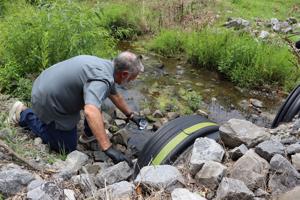Per- and polyfluoroalkyl substances (PFAS), often referred to as “forever chemicals,” are raising significant health and environmental concerns worldwide. Comprising over 10,000 different chemicals, PFAS are widely used in everyday products ranging from nonstick cookware and waterproof clothing to firefighting foam and dental floss. Their persistence in the environment and human body has prompted urgent calls for a comprehensive ban on their usage.
The term “forever chemicals” stems from their remarkable resistance to degradation, resulting in their accumulation in human blood, breast milk, and even remote areas like Antarctica. Alarmingly, a report from the National Institute for Public Health and the Environment in the Netherlands has warned residents against consuming eggs from backyard chickens due to elevated PFAS levels. Preliminary findings suggest that the chemicals may be entering the chickens’ diets through contaminated earthworms.
A recent analysis by Wildlife and Countryside Link and the Rivers Trust revealed that nearly all rivers, lakes, and ponds in England exceed proposed safety limits for PFAS, with 85% registering levels at least five times higher than acceptable. In France, tap water in 16 communes has been banned due to contamination, while the Forever Pollution Project identified approximately 23,000 contaminated sites across Europe.
The health implications associated with PFAS exposure are alarming. Studies have linked these chemicals to an increased risk of cancer, fertility issues, birth complications, and compromised immune systems. The Nordic Council of Ministers estimates that the healthcare costs related to PFAS could reach at least €52 billion ($57 billion) annually.
The industry response has been slow, with major manufacturers like 3M Co. and DuPont de Nemours Inc. facing lawsuits and public scrutiny over their handling of PFAS. Internal documents from these companies revealed they were aware of the toxicity of these substances for decades. While 3M announced plans to discontinue PFAS by the end of 2025, the broader industry remains resistant to change.
The global PFAS market is valued at just over $28 billion, but the cleanup costs in the UK and Europe alone could reach €100 billion ($116 billion) annually if proactive measures are not implemented. Despite some consumer brands, such as Patagonia Inc. and McDonald’s Corp., taking steps to phase out PFAS, many others continue to delay action.
Regulatory Landscape and Progress
Current regulatory efforts to address PFAS are fragmented. Denmark has enacted a ban on PFAS-treated clothing and waterproofing agents set to take effect in July 2026, while France has prohibited PFAS in several consumer product categories. Notably, cookware was excluded from France’s ban following lobbying efforts, raising concerns about the effectiveness of piecemeal prohibitions.
In March 2023, five European Union member states—Germany, the Netherlands, Sweden, Denmark, and Norway—submitted a comprehensive proposal to the European Chemicals Agency. This proposal aims to regulate all PFAS as a group rather than individually, a move supported by the charity CHEM Trust. This precautionary approach is crucial, given that under the current regulatory framework, it would take over 40,000 years to assess each chemical individually.
While the EU initiative represents significant progress, its implementation may take time, with potential regulations not coming into effect until 2028. In the UK, a recently published interim position on PFAS management has faced criticism for lacking comprehensive action.
In the United States, regulatory efforts have also stalled. The previous administration significantly reduced funding for PFAS research, while the Environmental Protection Agency has proposed rescinding drinking water limits for certain PFAS compounds.
The Path Forward
Despite the daunting challenges posed by PFAS contamination, there is hope for meaningful change. Banning the use of these harmful substances is critical, but it will take concerted action from governments, industries, and consumers alike.
The experience in Denmark, where blood concentrations of two banned PFAS chemicals—PFOS and PFOA—have significantly declined, demonstrates that restrictions can lead to positive health outcomes. It is imperative to move beyond incremental measures and adopt a universal ban on PFAS.
Taking decisive action now could pave the way for cleaning up the environmental mess caused by these chemicals and safeguarding public health. The world must stop “playing Whac-a-Mole” with PFAS and instead confront the issue head-on to ensure a healthier future for all.







































































